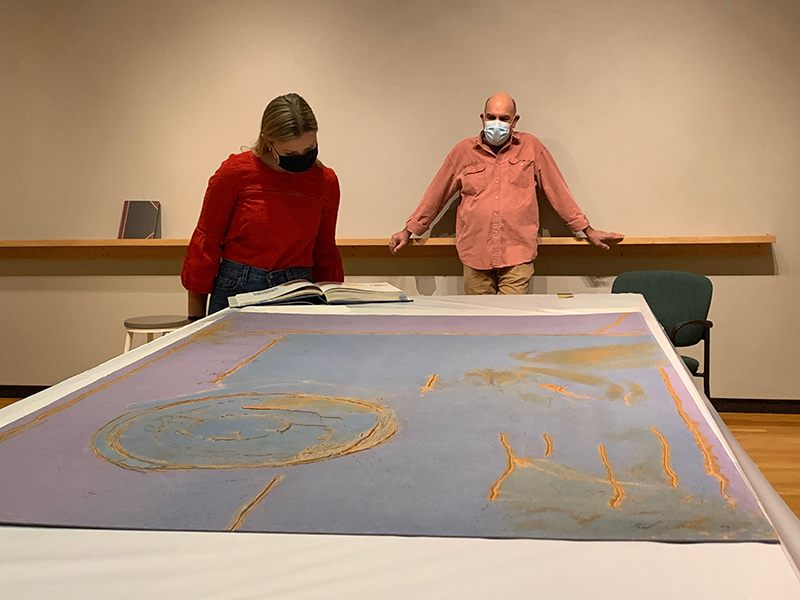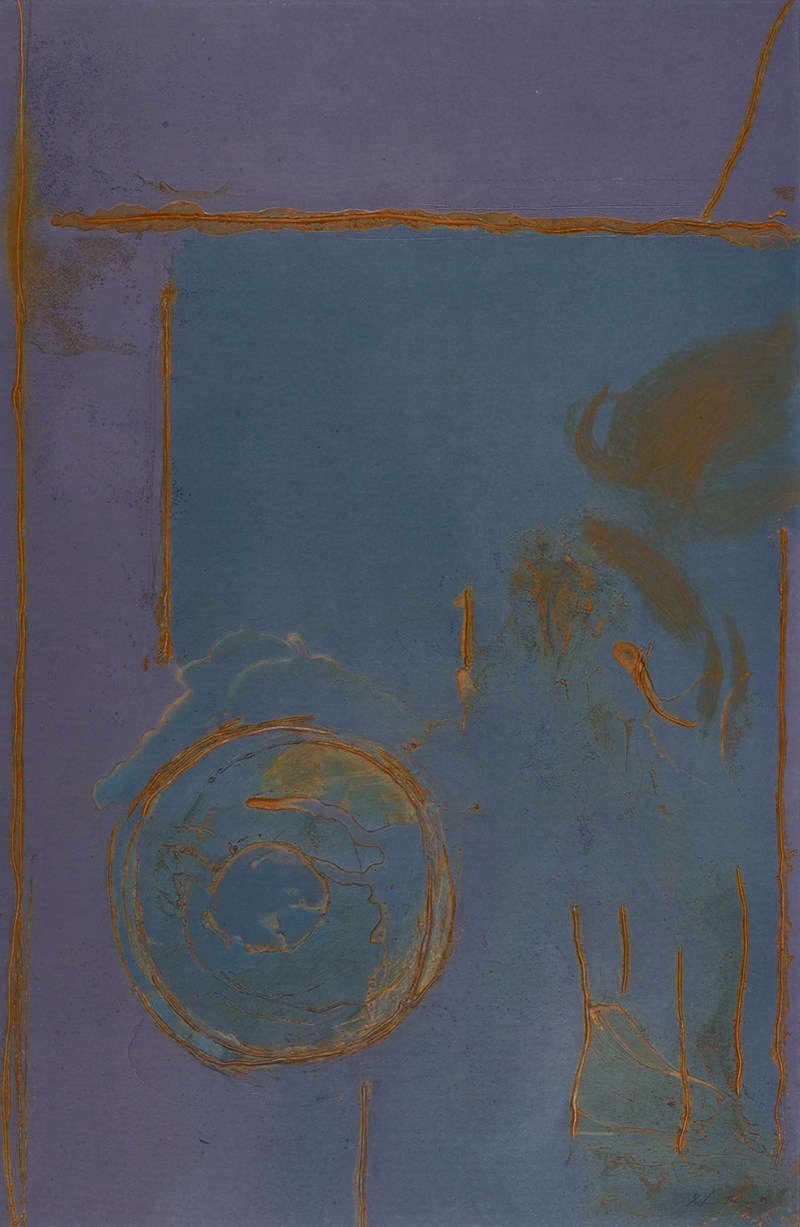The Critical Work of Helen Frankenthaler and Jo Sandman
By Bowdoin College Museum of Art
Sydney Reaper, Class of 2021, speaks about her research at the Bowdoin College Museum of Art during the spring semester.
This semester, I had the opportunity to work as an assistant to Anne Collins Goodyear, co-director of the BCMA, and to contribute to developing plans for future exhibitions of modern and contemporary works of art. One such exhibition will juxtapose works by two female artists, Helen Frankenthaler and Jo Sandman. Both artists built on the legacy of Abstract Expressionism, questioning traditional conventions and inventing new strategies for working with materials. Thanks to a generous gift from the Helen Frankenthaler Foundation and from the Estate of Jo Sandman, the Museum collections include notable selections of the work of these two artists. The Museum now houses nineteen of Helen Frankenthaler’s prints and nine works by Jo Sandman in various media. During my internship, I was given the extraordinary opportunity to study their work in person. Here I provide some reflections on my research of these two incredible artists and thinkers and my memorable encounters with two works: Guadalupe (1989) by Helen Frankenthaler and Untitled [Folded Drawing] (ca. 1970–71) by Jo Sandman.
 Frankenthaler is best known for her innovative technique of painting known as “soak-stain,” in which she thinned her oil paints with turpentine and then poured, dripped, or sponged colors onto the canvas. Jo Sandman is a Boston-based artist who works predominantly with found objects and humble materials such as automotive pipes and painter’s cloth. The points of connection between the two artists are numerous and deserving of further research: Frankenthaler studied with abstract painter Hans Hofmann in Provincetown, Massachusetts and Sandman received training from both Hofmann and Robert Motherwell, who would later become Frankenthaler’s husband. Frankenthaler received her Bachelor of Arts degree from Bennington College and Sandman studied at Black Mountain College, institutions which have emphasized the arts as central to a liberal arts education. These aspects of their artistic training make their work especially appropriate for a liberal arts college like Bowdoin, and are particularly interesting to me, as I prepare to graduate with a visual arts degree from Bowdoin. When one approaches the work of Frankenthaler or Sandman, there is a sense of their cross-disciplinary interests, critical eyes, and deep creative capacities that enable them to charter into unknown territory, as a liberal arts education should prepare us to do. As a visual artist myself, I have found my own perspective transformed by both Frankenthaler’s and Sandman’s bold interrogations of the conventions of art making.
Frankenthaler is best known for her innovative technique of painting known as “soak-stain,” in which she thinned her oil paints with turpentine and then poured, dripped, or sponged colors onto the canvas. Jo Sandman is a Boston-based artist who works predominantly with found objects and humble materials such as automotive pipes and painter’s cloth. The points of connection between the two artists are numerous and deserving of further research: Frankenthaler studied with abstract painter Hans Hofmann in Provincetown, Massachusetts and Sandman received training from both Hofmann and Robert Motherwell, who would later become Frankenthaler’s husband. Frankenthaler received her Bachelor of Arts degree from Bennington College and Sandman studied at Black Mountain College, institutions which have emphasized the arts as central to a liberal arts education. These aspects of their artistic training make their work especially appropriate for a liberal arts college like Bowdoin, and are particularly interesting to me, as I prepare to graduate with a visual arts degree from Bowdoin. When one approaches the work of Frankenthaler or Sandman, there is a sense of their cross-disciplinary interests, critical eyes, and deep creative capacities that enable them to charter into unknown territory, as a liberal arts education should prepare us to do. As a visual artist myself, I have found my own perspective transformed by both Frankenthaler’s and Sandman’s bold interrogations of the conventions of art making.
Frankenthaler’s Guadalupe is a sizable print on paper, measuring 69 inches tall by 45 inches wide, created through mixographia. Mixografia is an experimental process of printmaking invented by Luis Remba in which the artist first produces a matrix in various materials—Frankenthaler used both plaster and wax for this purpose—and then uses a copper plate created by Remba’s workshop. The plate reflects the negative space of the matrix. I made my way around the print as it was displayed on a table, taking in the subtle gradations of ultramarine blue into violet and its varying signs of mark-making. The complexity of the print’s surface foregrounds considerations of the artist’s process, inviting you to make a calculated guess of Frankenthaler’s chosen materials, technique, and order in which she applied elements onto either the print or paper. In the upper left-hand corner of the work, there are numerous marks that dot the surface, but their size and spacing is not uniform. I discovered that these marks–which I speculated could have been applied to the matrix with a fork or wire brush–were a result of the wax being applied with a wire brush to the matrix, thereby solving the puzzle of their irregularity. Frankenthaler makes a three-dimensional object with a two-dimensional surface; the matrix of Guadalupe forms deep grooves and organic shapes on the thick, hand-made paper. On one picture plane, Frankenthaler combines the visual language of multiple artistic practices: that of line in drawing, color in painting, and positive and negative space in sculpture.
In Untitled [Folded Drawing], Sandman fuses image and ground by creating creases in an unprimed and unstretched canvas that, when released from their folds, produce a symmetrical design. Like Frankenthaler’s Guadalupe, this piece is composed of forms both embedded within the material and protruding out from it. Sandman creates positive and negative space by applying pressure to the canvas with an iron, much like how Frankenthaler and her collaborators pressed the matrix to the paper of Guadalupe. Both works reverse our expectations of how we may approach a work on a two-dimensional surface. Instead of making a distanced observation of what lies on the surface, we get up close, noting shifts where the paper or canvas takes on a sculptural form. Untitled [Folded Drawing] challenges conventions of painting by revealing the canvas for what it is. As a painter, I am reminded of the painstaking process before starting a work in which the canvas is stretched, sanded, and primed so that its weave, color, and other physical components disappear to make way for a new picture. Although the title of the work indicates it is a drawing, I am not certain it can be so easily classified. From a distance, its symmetrical design of lines appear drawn on the surface; I approached the work as a two-dimensional picture. But as I moved closer, the lines became light and shadow and the background became a weave of thread. Over time and from a closer distance, the work is insistent on its own materiality. Sandman’s work reminds me of the work of contemporary artist Tauba Auerbach, who twists and folds her canvases and then applies paint to create a trompe l’oeil rendering of the material’s previous three-dimensional state. The questions posed by Sandman about art making in Untitled [Folded Drawing], then, continue to drive the practice of artists today. Sandman presents a “drawing” that breaks out from the two-dimensional picture plane, thus moving her work beyond purely visual interpretation and presenting new possibilities for drawing beyond the traditional act of touching pencil to paper.
I am forever grateful for these two female artists’ contributions to the history of art through their experimental practices and their impact on my experience as a visual artist and Intern at the Bowdoin College Museum of Art. I look forward to when their work can be displayed in the galleries of the Museum and to when we all have the chance to interact with works in person once again!
Sydney Reaper, Bowdoin Class of 2021Student Curatorial Assistant
Bowdoin College Museum of Art
Illustration: Guadalupe, 1989, mixografia, by Helen Frankenthaler, American, 1928–2011. Gift of the Helen Frankenthaler Foundation. Bowdoin College Museum of Art. Photography by Luc Demers.